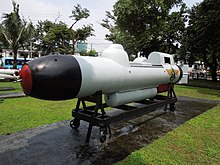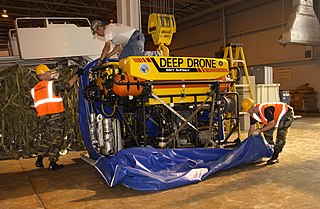This article needs additional citations for verification .(October 2013) |
CosMoS CE2F were a series of swimmer delivery vehicles (SDV) built by M/s Cos.Mo.S Spa. which was based in Livorno, Italy.
This article needs additional citations for verification .(October 2013) |
CosMoS CE2F were a series of swimmer delivery vehicles (SDV) built by M/s Cos.Mo.S Spa. which was based in Livorno, Italy.


The craft weighs 2,100 kilograms (4,600 lb) out of water and is 7 or 8 metres (23 ft 0 in or 26 ft 3 in) long according to type. It resembles a torpedo but has two cockpits for the crew. Some models have a roof with sliding doors for the cockpits. In some models the rear cockpit is long and can seat two divers for a total crew of three. Its battery-electric motors gives it a submerged range of 50 nautical miles (93 km; 58 mi) at 4 knots (7.4 km/h; 4.6 mph), the maximum speed being 5 knots (9.3 km/h; 5.8 mph). For long distance it generally reaches the operating area either attached to or towed by another vessel. A belly-pan beneath its hull can carry special equipment, or 230 kg (510 lb) of heavy explosive charges, or 150 kg (330 lb) of limpet mines, or small 'micro-torpedoes' stated to be for use against divers or small underwater vehicles. They were made in various variants and supplied to various countries. Models were designated according to maximum operating depth in metres, for example - /X30 means 30 m. X30, X60 and X100 versions were sold. The /X100T version was the most advanced type marketed showing the final evolution of the design. It has digital control module, displaying navigation and platform details, and a fully integrated autopilot. [1] [2]
Images (see the references below) of the roofed versions of these vehicles show no forward direct vision windows (but only side windows in the sliding doors), and pilot vision was by a screen in the cockpit from a television camera, likeliest in the front of the vehicle's hemispherical bow; this presumably would prevent carriage of a warhead or other load by attaching it to the front of the bow as was done on World War II human torpedoes.

A frogman is someone who is trained in scuba diving or swimming underwater in a tactical capacity that includes military, and in some European countries, police work. Such personnel are also known by the more formal names of combat diver, combatant diver, or combat swimmer. The word frogman first arose in the stage name the "Fearless Frogman" of Paul Boyton in the 1870s and later was claimed by John Spence, an enlisted member of the U.S. Navy and member of the OSS Maritime Unit, to have been applied to him while he was training in a green waterproof suit.

A diver propulsion vehicle (DPV), also known as an underwater propulsion vehicle, sea scooter, underwater scooter, or swimmer delivery vehicle (SDV) by armed forces, is an item of diving equipment used by scuba divers to increase range underwater. Range is restricted by the amount of breathing gas that can be carried, the rate at which that breathing gas is consumed, and the battery power of the DPV. Time limits imposed on the diver by decompression requirements may also limit safe range in practice. DPVs have recreational, scientific and military applications.

A midget submarine is any submarine under 150 tons, typically operated by a crew of one or two but sometimes up to six or nine, with little or no on-board living accommodation. They normally work with mother ships, from which they are launched and recovered and which provide living accommodation for the crew and support staff.

The SEAL Delivery Vehicle (SDV) is a crewed submersible and a type of swimmer delivery vehicle used to deliver United States Navy SEALs and their equipment for special operations missions. It is also operated by the Royal Navy's Special Boat Service, which operates three SDVs.

Human torpedoes or manned torpedoes are a type of diver propulsion vehicle on which the diver rides, generally in a seated position behind a fairing. They were used as secret naval weapons in World War II. The basic concept is still in use.

The Deep Drone is a submersible remotely operated vehicle designed for mid-water salvage for the United States Navy. One vehicle is based in Largo, Maryland, under the command of The U.S. Navy Supervisor of Salvage and Diving (SUPSALV), it is maintained and operated by Phoenix International Inc.. The vehicle is capable of operating at a depth up to 8000 feet as reflected in its full name: "The Deep Drone 8000". The vehicle has a target locating sonar and two tool manipulators capable of working with tools and attaching rigging.

A wet sub is a type of underwater vehicle, either a submarine or a submersible, that does not provide a dry environment for its occupants. It is also described as an underwater vehicle where occupants are exposed to ambient environment during operations. The watercraft is classified as medium-sized or small vessel. This type of submarine differs from other underwater personal transport devices by the fact that it has a hull around it and it is not a "bare bones" design.
German submarine U-978 was a World War II Type VIIC U-boat operated by Nazi Germany's Kriegsmarine. She completed the longest underwater patrol of World War II.

German submarine U-301 was a Type VIIC U-boat built for the German Navy (Kriegsmarine) during World War II. The submarine was laid down on 12 February 1941 at the Flender Werke yard at Lübeck, launched on 25 March 1942, and commissioned on 9 May 1942. During her short career the U-boat sailed on three combat patrols, without sinking or damaging any ships, before she was sunk on 21 January 1943 by a British submarine in the Mediterranean Sea.

The Motorised Submersible Canoe (MSC), nicknamed Sleeping Beauty, was built by the British Special Operations Executive (SOE) during World War II as an underwater vehicle for a single frogman to perform clandestine reconnaissance or attacks against enemy vessels.
There have been a number of 18-inch torpedoes in service with the United Kingdom.

The Cosmos-class submarine, officially Cos.Mo.S MG-110 locally designated as X-Craft, are the class of midget submarines designed by the Italian firm Cos.Mo.S, in Karachi Naval Dockyard in Karachi, Sindh, Pakistan.
German submarine U-133 was a Type VIIC U-boat built for Nazi Germany's Kriegsmarine for service during World War II. She was laid down on 21 August 1940 by Vegesacker Werft, Bremen-Vegesack as yard number 12, launched on 28 April 1941 and commissioned on 5 July that year. U-133 sank with all hands lost after striking a mine off Aegina island Greece on 14 March 1942. In 1986 the professional divers Efstáthios "Státhis" Baramátis and Theófilos Klímis spotted by chance a wreck at a depth of 74 meters that was identified as an unknown German submarine. Almost ten years later, in the mid-90s, the same wreck was further identified by Greek divers as the U-133.

The Type 37 torpedo boat was a class of nine torpedo boats built for Nazi Germany's Kriegsmarine during World War II. Completed in 1941–1942, one boat helped to escort a commerce raider passing through the English Channel into the Atlantic Ocean in late 1941, but their first major action was in early 1942 when they formed part of the escort for a pair of battleships and a heavy cruiser through the Channel back to Germany in the Channel Dash. Two pairs of boats were sent to France at different times in mid-1942 and were part of the escort during an unsuccessful attempt to pass a different commerce raider back through the Channel in October. One boat was assigned to the Torpedo School as a training ship in mid-1942 and the others followed in the next year.

The R-2 Mala is a class of swimmer delivery vehicles (SDVs) built for the Yugoslav, and later on, Croatian Navy. The two man wet SDVs are used for transporting naval commandos into hostile waters where they would perform sabotage on enemy warships and coastal installations. Weapons at their disposal included limpet mines.

German submarine U-998 was a Type VIIC/41 U-boat of Nazi Germany's Kriegsmarine during World War II.
The Type 1941 torpedo boats were a group of 15 torpedo boats that were built for Nazi Germany's Kriegsmarine during World War II. Ordered in late 1942, none of the ships were finished before the German surrender on 8/9 May 1945, although four of the ships had been towed west to be completed earlier in that year. They were all either scuttled or demolished in the shipyard in 1945–1946.
CABI Cattaneo is an Italian boat and submersible builder which primarily supplies the Special Operations Forces market. Due to the nature of their work they are extremely secretive.
Cos.Mo.S, officially Costruzione Motoscafi Sottomarini s.a.s, was an Italian submarine and submersible manufacturer.
The Windermere is a tourist submarine that operated on Windermere, a lake in Cumbria, England. It was delivered to the marina at Lakeside in July 1997 and began commercial operation the next month. Carrying out dives on a wreck near to the marina and also cruises further afield it carried 3,500 passengers in its first year of operations. The Windermere struggled to attract full loads of passengers in 1998, which was its last year of operation. The vessel was later operated in Mauritius and now carries out dives in Barbados.